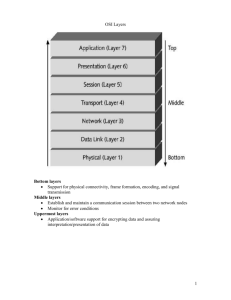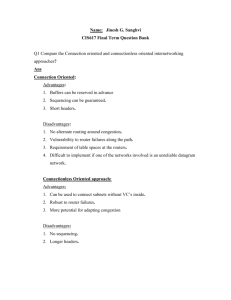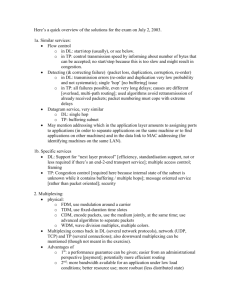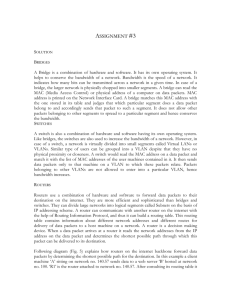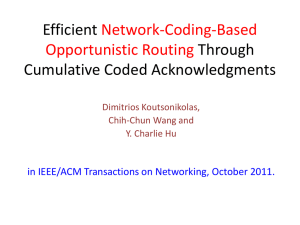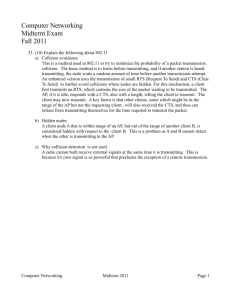Computer Network Homework: Routing, Algorithms, Congestion
advertisement
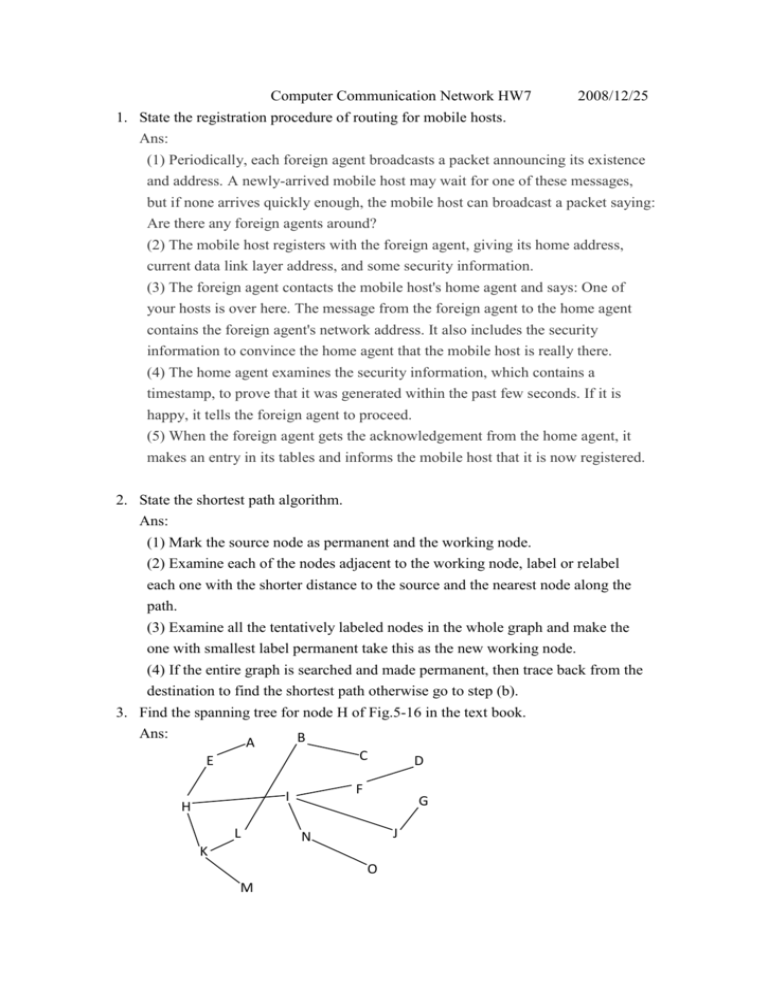
Computer Communication Network HW7 2008/12/25 1. State the registration procedure of routing for mobile hosts. Ans: (1) Periodically, each foreign agent broadcasts a packet announcing its existence and address. A newly-arrived mobile host may wait for one of these messages, but if none arrives quickly enough, the mobile host can broadcast a packet saying: Are there any foreign agents around? (2) The mobile host registers with the foreign agent, giving its home address, current data link layer address, and some security information. (3) The foreign agent contacts the mobile host's home agent and says: One of your hosts is over here. The message from the foreign agent to the home agent contains the foreign agent's network address. It also includes the security information to convince the home agent that the mobile host is really there. (4) The home agent examines the security information, which contains a timestamp, to prove that it was generated within the past few seconds. If it is happy, it tells the foreign agent to proceed. (5) When the foreign agent gets the acknowledgement from the home agent, it makes an entry in its tables and informs the mobile host that it is now registered. 2. State the shortest path algorithm. Ans: (1) Mark the source node as permanent and the working node. (2) Examine each of the nodes adjacent to the working node, label or relabel each one with the shorter distance to the source and the nearest node along the path. (3) Examine all the tentatively labeled nodes in the whole graph and make the one with smallest label permanent take this as the new working node. (4) If the entire graph is searched and made permanent, then trace back from the destination to find the shortest path otherwise go to step (b). 3. Find the spanning tree for node H of Fig.5-16 in the text book. Ans: B N A E L G J N K O M D F I H C 這只是其中一種寫法. 4. Datagram subnets route each packet as a separate unit, independent of all others. Virtual-circuit subnets do not have to do this, since each data packet follows a predetermined route. Does this observation mean that virtual-circuit subnets do not need the capability to route isolated packets from an arbitrary source to an arbitrary destination? Explain your answer. Ans: Virtual circuit networks most certainly need this capability in order to route connection setup packets from an arbitrary source to an arbitrary destination. 5. For hierarchical routing with 4800 routers, what region and cluster sizes should be chosen to minimize the size of the routing table for a three-layer hierarchy? A good starting place is the hypothesis that a solution with k clusters of k regions of k routers is close to optimal, which means that k is about the cube root of 4800 (around 16). Use trial and error to check out combinations where all three parameters are in the general vicinity of 16. Ans: The minimum occurs at 15 clusters, each with 16 regions, each region having 20 routers, or one of the equivalent forms, e.g., 20 clusters of 16 regions of 15 routers. In all cases the table size is 15 + 16 + 20 = 51. 6. Looking at the subnet of Fig. 5-6, how many packets are generated by a broadcast from B, using (a) reverse path forwarding? (b) the sink tree? Ans: (a) 2+4+10+8+4=28 B C A D G H K E F O L H I L I F G M D J J E I N H M O L H (b) The sink tree needs four rounds and 14 packets. 7. (a) Why random early detection (RED) method is mainly used in a datagram subnet? (b) Does RED method will work well in a wireless subnet? Ans: (a) It is well known that dealing with congestion after it is first detected is more effective than letting it gum up the works and then trying to deal with it. This observation leads to the idea of discarding packets before all the buffer space is really exhausted. In some transport protocols (including TCP), the response to lost packets is for the source to slow down. The reasoning behind this logic is that TCP was designed for wired networks and wired networks are very reliable, so lost packets are mostly due to buffer overruns rather than transmission errors. This fact can be exploited to help reduce congestion. By having routers drop packets before the situation has become hopeless (hence the ''early'' in the name), the idea is that there is time for action to be taken before it is too late. To determine when to start discarding, routers maintain a running average of their queue lengths. When the average queue length on some line exceeds a threshold, the line is said to be congested and action is taken. Since the router probably cannot tell which source is causing most of the trouble, picking a packet at random from the queue that triggered the action is probably as good as it can do. (Datagram的封包遺失大都是因為緩衝區溢位,而非傳輸錯誤產生,故可在 router狀況更糟之前處理,也就是提早丟棄封包) (b) NO. In wireless networks, where most losses are due to noise on the air link, this approach cannot be used.
